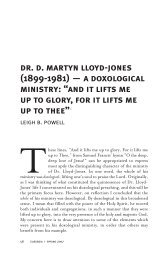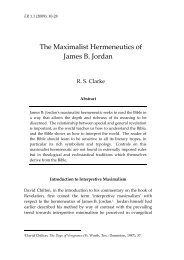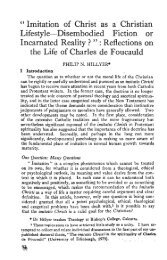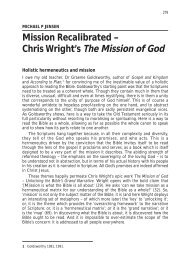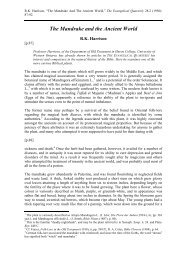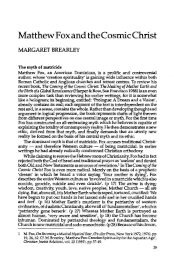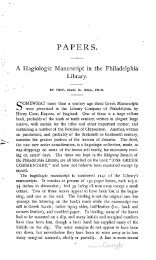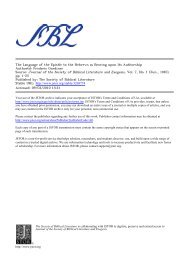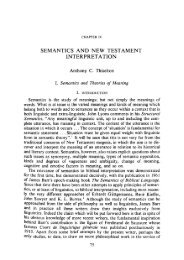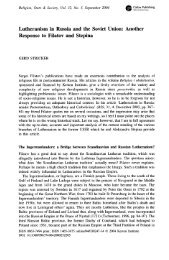Ancient Orient and Old Testament - BiblicalStudies.org.uk
Ancient Orient and Old Testament - BiblicalStudies.org.uk
Ancient Orient and Old Testament - BiblicalStudies.org.uk
Create successful ePaper yourself
Turn your PDF publications into a flip-book with our unique Google optimized e-Paper software.
K.A. Kitchen, <strong>Ancient</strong> <strong>Orient</strong> <strong>and</strong> <strong>Old</strong> <strong>Testament</strong>. London: Inter-Varsity Press, 1966. Hbk. pp.191.<br />
2. Asher in Palestine before the Exodus. In Egyptian documents Cf c. 1300-1250 BC, 51 a placename<br />
1-s-r in Palestine was identified by some with the biblical tribe of Asher, <strong>and</strong> it was then argued<br />
that this tribe was already in Palestine before the main Exodus took place: either they had a separate<br />
Exodus, or were never in Egypt. 52 But recently, the proper Egyptian transcription of the name Asher<br />
has been recovered: it is 1-sh-r (i-1r) not i-s-r - so the references to i-s-r have nothing to do with the<br />
biblical Asher, <strong>and</strong> the theories based on this false equation must be ab<strong>and</strong>oned. 53 The supposed<br />
references to Asher,<br />
[p.71]<br />
Zebulon, etc., in the Ugaritic epics were proved to be nonexistent long ago. 54<br />
3. More than one Exodus <strong>and</strong> Some Tribes Never in Egypt. The uniform biblical tradition at all<br />
levels records that all of Jacob’s sons entered Egypt (e.g., Gn. 46:8-27; Ex. 1:1-5), <strong>and</strong> knows of<br />
only one Exodus by their descendants (cf. Ex. 24:4; Nu. 1, 2, I o: 14 ff.). They were<br />
accompanied by a variety of heterogeneous elements (cf. Ex. 12:38; Nu. 11:4), <strong>and</strong> yet more were<br />
joined with Israel subsequently (e.g., the Kenites, Nu. 10:29; Jdg. I :16; 1 Sa. 27:10). There is<br />
not a scrap of clear, explicit evidence for more than one Exodus or for some tribes never going into<br />
Egypt. The supposed Egyptian <strong>and</strong> Ugaritic evidence is illusory (see previous paragraph). The events<br />
of Genesis 34 belong explicitly to the time of Jacob, <strong>and</strong> have nothing to do with any later period<br />
(the Amarna age, for example; Labayu <strong>and</strong> his sons, not Hamor, ruled Shechem then). 55 The fact that<br />
Joshua <strong>and</strong> judges do not record an Israelite conquest of the Shechem area of Palestine may show<br />
nothing more than the fact that our biblical records are not exhaustive sources for the period, <strong>and</strong><br />
were never intended to be so read. One cannot (<strong>and</strong> should not) build theories on a void. 56 It should be<br />
evident from<br />
51 In topographical lists: J. Simons, H<strong>and</strong>book... of Egyptian Topographical Lists, 1937, pp. 147 (XVII:4), 162<br />
(XXV:8). In Papyrus Anastasi I: Gardiner, Egyptian Hieratic Texts, I, 1911, p. 25* note 12, <strong>and</strong> <strong>Ancient</strong><br />
Egyptian Onomastica, I, 1947, pp. 191*-193* (No. 265); M. Burchardt, Altkanaanäische Fremdworte <strong>and</strong><br />
Eigennamen..., 1911, No. 139.<br />
52 For example, Rowley, From Joseph to Joshua, pp. 3, 33-35, etc.<br />
53 See Albright, JAOS 74 (1954), pp. 229 - 231 <strong>and</strong> n. 51, 232 <strong>and</strong> n. 58a (on Papyrus Brooklyn 35.1446 of<br />
eighteenth century BC). S. Yeivin, Mélanges Bibliques Andri Robert, 1957, pp. 98- - 9, preferring the old<br />
combination, dismissed Albright’s view as hasty. But Yeivin has himself been too hasty. (i) Heb. Asher <strong>and</strong> Eg.<br />
’i-sh-r do not go with ’i-s-r <strong>and</strong> the goddess Ashirat, because the latter has nothing to do with the root ‘good<br />
fortune’ but in Ugaritic is ’Athirat yammi, ‘She who walks the Sea’ or the like (cf. Albright, Archaeology <strong>and</strong><br />
the Religion of Israeli, 1953, pp. 77-8). (ii) Albright’s JAOS equation is in line with the table BASOR 110<br />
(1948), p. 15 n. 42, see remarks on Eg. equivalents before the table, <strong>and</strong> cf. table of F. M. Cross, HTR 55<br />
(1962), p. 245 n. 95. Hence Albright’s view must be retained.<br />
54 On this, see Albright, BASOR 63 (1936), pp. 27-32, <strong>and</strong> ibid. 71 (1938), pp. 35 - 40; R. de Langhe, Les Textes<br />
de Ras Shamra-Ugarit..., II, 1945, pp. 469 - 519.<br />
55 Both Rowley, From Joseph to Joshua, pp. 113-114, 124, etc., <strong>and</strong> Eissfeldt, CAH 2 , II: 26a (Palestine in the<br />
Nineteenth Dynasty...), 1965, pp. 13, 24 with p. 8 (date of patriarchs) <strong>and</strong> CAH 2 , 11:34 (The Hebrew Kingdom),<br />
1965, pp. 7-8, put the patriarchs <strong>and</strong> the events of Gn. 34 in the Amarna age; as noted, Labayu, not Hamor, was<br />
at Shechem then, <strong>and</strong> as shown in §II of chapter 2, the patriarchs must be dated much earlier than the Amarna<br />
age.<br />
56 This is not to deny that some Hebrews could have left Egypt long before the Exodus; but if so, we have no<br />
explicit biblical record of such – the Patriarchs are people, not tribal personifications. The silence on central<br />
Palestine could reflect a rapid link-up with Hebrews already there, but of itself does not constitute direct




